Wind Surfing in Oahu: Techniques, Spots, and Culture
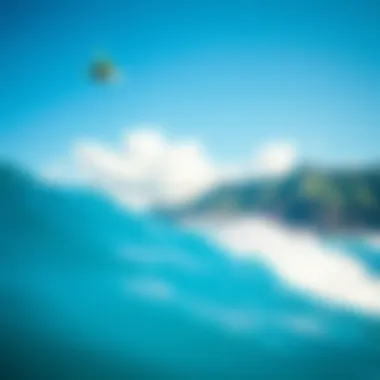
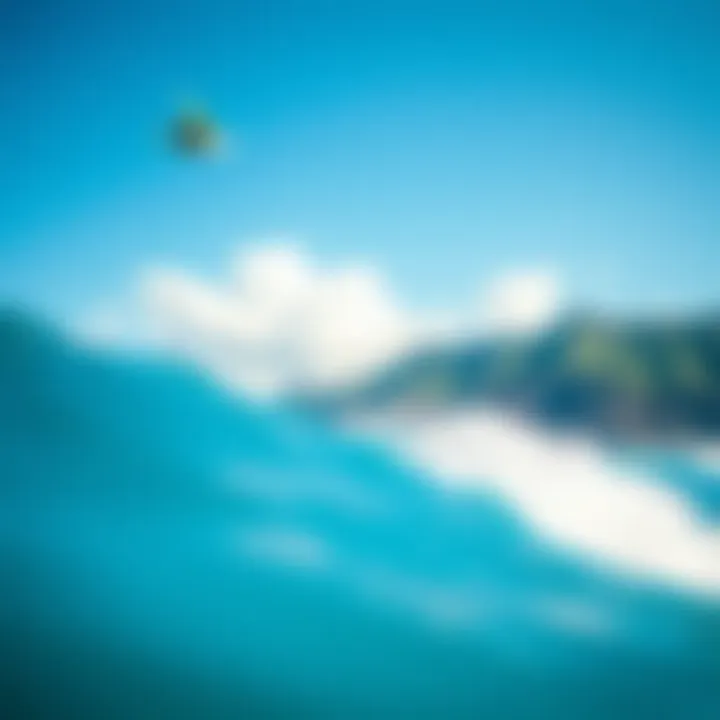
Intro
Wind surfing in Oahu is more than just a sport; it’s a way of life that intertwines with the very fabric of Hawaiian culture. As waves dance across the shimmering surface and the gentle breezes whisper through the palm trees, surfers from all walks of life are drawn to this paradise where the wind and water create an exhilarating playground.
In this exploration, we will navigate the various facets of wind surfing in Oahu—highlighting techniques that can elevate one’s game, pinpointing prime surfing spots that beckon enthusiasts, and delving into the rich cultural significance that binds surfers together in a communal spirit of adventure and respect for nature. Whether you’re a seasoned wind surfer or a curious newcomer eager to dip your toes in, this piece aims to inform and inspire.
With an understanding of the unique wind conditions that Hawaii offers year-round, coupled with insights into essential equipment and sustainable practices, you’ll be well on your way to catching not just waves but the very essence of what makes wind surfing in Oahu a truly unforgettable experience.
Surfing Techniques
Mastering the Basics
Every great wind surfer starts from the same place, mastering the foundational techniques that will serve as the bedrock of their surfing journey. The first step is to find a reliable location with consistent winds, such as Kailua Beach or the renowned Kanaha Beach Park. These spots offer favorable conditions for beginners to learn how to harness the wind while gliding over the water.
Basic techniques include:
- Stance: Keeping a balanced posture is vital; standing with feet shoulder-width apart while bending your knees helps maintain stability.
- Sail Handling: Understanding how to control the sail is crucial. Pulling on the uphaul cord to raise the sail and managing the boom will help you navigate effectively.
- Tacking and Gybing: These maneuvers are essential for changing direction. Practicing these maneuvers in sheltered waters allows surfers to gain confidence as they learn to pivot and control their boards.
As surfers become comfortable with these elementary skills, the joy of wind surfing truly begins to flourish.
Advanced Maneuvers
Once the basics are second nature, many surfers look to add some pizzazz to their sessions with advanced maneuvers. These techniques showcase skills and creativity, transforming a simple day out on the water into an opportunity for personal expression. Some notable advanced techniques include:
- Jumping: Taking off from a wave or swell and launching into the air, then landing back smoothly is not just thrilling but visually captivating.
- Waveriding: Mastering the art of riding across waves requires timing and precision, allowing surfers to carve their boards gracefully while harnessing the wave’s power.
- Freestyle Moves: Advanced wind surfers often incorporate spins, flips, and even slides into their repertoire, showcasing agility and style. Practicing these moves can transform even the most experienced surfer’s routine.
"Wind surfing is an art form; every turn, every jump, every moment on the water is a chance to express yourself. It's where freedom dances with nature and skill met sophistication."
Surfing Lifestyle
Sustainable Surfing Practices
As wind surfing continues to grow in popularity, there’s a pressing need to address the environmental impact associated with the sport. Sustainable surfing practices foster a culture of respect for the ocean and the stunning landscapes that serve as our playgrounds. Some simple yet effective practices include:
- Leave No Trace: Always pick up after yourself; this includes trash and any wax or materials used.
- Eco-Friendly Gear: Opt for environmentally sustainable surfboards and equipment that minimize harm to the oceans during production.
- Awareness of Local Ecosystems: Educate yourself about the local marine life and ecosystems to avoid disruption and damage while out on the water.
Embracing these ideals reinforces not only respect for the ocean but enhances the overall surfing community's longevity.
Surf Culture Around the World
Surf culture is as diverse as the waves that surfers ride. From the sandy beaches of Oahu to the rocky shores of Portugal, wind surfing unites enthusiasts across the globe. Each locale adds its unique flavor to the lifestyle, with local traditions and customs influencing everything from the gear used to the community events celebrated.
In Oahu, the Aloha spirit permeates every surfer's life. This attitude encompasses kindness, mutual respect, and a deep-seated love for the ocean. Surfers can often be seen gathering for community clean-ups, sharing stories of their ocean encounters, or even organizing surf competitions that celebrate skill and camaraderie.
As wind surfing continues to evolve, so too will the culture surrounding it. Engaging with the community not only enriches the surfing experience but enhances personal growth and appreciation for the sport.
In summary, Oahu is not just a destination for wind surfing; it’s a vibrant tapestry of techniques, lifestyles, and deep-rooted culture that beckon both seasoned veterans and newcomers alike to embrace the waves and the enriching experiences that come with them.
Prelims to Wind Surfing in Oahu
Wind surfing holds a unique charm that attracts thrill-seekers and nature lovers alike, especially on the island of Oahu. Known as the gathering place for the Hawaiian Islands, Oahu offers not just stunning landscapes but also a wind surfing culture that thrives in its unique climate and geography. The sport combines elements of surfing and sailing, making it particularly engaging. It's this blend of adrenaline and connection to nature that captivates both seasoned wind surfers and newcomers.
The significance of wind surfing in Oahu transcends the mere act of riding the waves; it embodies a lifestyle deeply intertwined with the Aloha spirit. As one stands atop a board, held by the wind, the sensations of freedom and harmony with the ocean emerge, creating a deeply rewarding experience. From sociable beach gatherings to intense competitions, wind surfing has shaped community bonds in a way that many other sports haven't.
Exploring wind surfing in Oahu isn't just about the thrill; it's a journey into understanding the local culture, the environmental considerations it involves, and how the island's unique geographical features influence surf conditions.
Key Elements of Wind Surfing in Oahu
Wind surfing can initially seem daunting, yet its allure is hard to resist. Here are some aspects worth considering:
- Cultural Influence: The sport has a rich history here, influencing local traditions and lifestyles. Understanding this cultural backdrop can enhance the experience of anyone looking to take part.
- Natural Conditions: Oahu's coastlines offer diverse wind patterns and wave conditions often preferred by wind surfers. Locations like Kailua and Kanaha become playgrounds due to their ideal features.
- Community: The local wind surfing community is welcoming, offering support and guidance for newcomers. Participating in local events is a great way to dive deeper into the sport.
"In Hawaii, when you catch the wind, you catch the essence of life itself. It’s freedom, it’s culture, and it’s connection."
As we delve deeper into the mechanics, techniques, and locations that make Oahu a wind surfing haven, it's clear that every wave tells a story.
Understanding Wind Surfing
Wind surfing is not just a sport; it’s a blend of art and science that thrives on the dynamic relationship between human skill and nature's forces. This section dives into the essence of wind surfing, laying a solid foundation for both newbies and seasoned enthusiasts alike. The importance of understanding the nuances of this discipline cannot be overstated, as it enhances performance and enriches the overall experience.
Wind surfing engages with the wind, waves, and personal technique, creating a symphony of motion when executed well. A grasp of the fundamentals helps surfers not only ride the waves but also appreciate the elements that affect their experience. By studying the principles behind the sport, enthusiasts can improve their techniques, connect with fellow surfers, and even advocate for sustainable practices.
Definition and Key Concepts
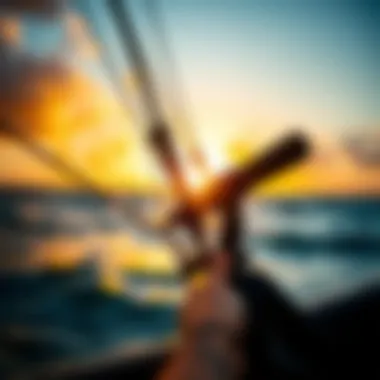
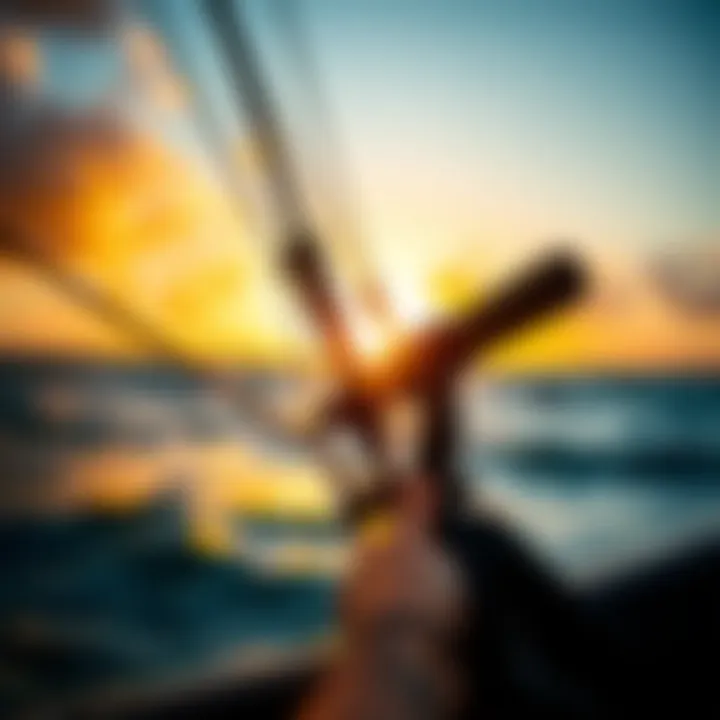
Wind surfing combines elements of traditional surfing and sailing. At its core, it revolves around riding a board attached to a sail while harnessing the wind's energy. It requires understanding several key concepts that shape how this sport is practiced:
- Board Types: Different shapes and sizes of boards are crafted for various skill levels and conditions, from beginner-friendly boards to high-performance ones for skilled sailors.
- Sail Types: Sails come in various sizes and designs, each catering to different wind conditions and styles of riding. Knowing how to choose the right sail is crucial for a positive experience.
- Wind Conditions: Awareness of wind speed and direction can determine the type of equipment to use and whether it's a good day for wind surfing.
Wind surf culture is also impacted by these definitions. As surfers advance, they often engage with more complex maneuvers, pushing the boundaries of the sport. The interaction with the environment deepens, making them advocates for respecting nature and its resources. Wind surfing becomes a shared passion, linking individuals through their experiences on the water.
Difference between Wind Surfing and Other Surfing Disciplines
While wind surfing shares similarities with disciplines like traditional surfing and kite surfing, there are distinct differences worth noting.
- Activity Mechanics: Traditional surfing relies solely on sea waves, while wind surfing incorporates both wind and water, giving practitioners a broader range of conditions to master.
- Tool Manipulation: In wind surfing, surfers control a sail for propulsion, which involves a fundamental understanding of both sailing and surfing dynamics. Unlike kite surfing, which utilizes a kite tethered to the surfer, wind surfers must balance on the board and maneuver the sail at the same time, requiring different skills.
- Physical Engagement: The level of physical engagement varies. Wind surfers must work against the sail's force, providing a unique workout that emphasizes balance, upper-body strength, and strategic movement.
Oahu’s Unique Wind and Water Conditions
Oahu is a playground for wind surfers, drawing enthusiasts from all corners of the globe to its waters. The interplay between the island's geography, wind patterns, and wave characteristics creates an environment that is often hailed as one of the best for wind surfing. Without understanding these unique conditions, one's experience may lack the sheer excitement this sport offers.
It's essential to grasp how these factors contribute to a successful wind surfing adventure. Not only do the winds dictate when and where to surf, but they also directly impact the types of maneuvers one can execute. Let’s break it down.
Seasonal Wind Patterns
Wind patterns on Oahu change throughout the year, significantly affecting surf conditions.
- Trade Winds: Dominantly blowing from the east, trade winds typically range around 15-25 knots, making for great sessions. They are strongest during the summer months, providing consistent opportunities.
- Winter Swells: In contrast, the winter season introduces larger swells that may not reach their full potential for wind surfing but can enhance the overall experience, as surfers adapt their techniques to the choppier waters.
Local knowledge is invaluable. Understanding when to ride the waves and when to seek calmer conditions allows surfers to maximize their time on the water.
Wave Characteristics
Oahu's wave conditions are as varied as its landscapes. Surfers here experience a delightful mix of rocky breaks and sandy bottoms. The waves boast their own personalities, influenced by both wind currents and geographical factors:
- Breaking Waves: Locations such as Kailua Beach provide ideal, breaking waves, excellent for both newcomers and seasoned surfers. The reliable breaks nurture skill-building and confidence.
- Choppy Waters: Some areas may experience choppy conditions due to gusts or abrupt shifts in wind direction, which may be challenging but can also serve as an excellent training ground.
Being aware of these characteristics enables wind surfers to tailor their techniques accordingly, refining their maneuvers while safely navigating the sometimes unpredictable ocean.
Impact of Geography on Surfing Conditions
The diverse landscape of Oahu has a profound effect on surf conditions:
- Coastal Features: From the towering cliffs at Diamond Head to the flat expanses of Kanaha Beach Park, the island's coastlines create dynamic water patterns. These geographical elements alter the wind's path and the waves that rise in response.
- Exposure to Elements: Certain beaches may be more sheltered, providing less wind and more manageable conditions, whereas others open up to the full force of nature’s elements. Suited for different skill levels and preferences, these contrasting locales benefit every type of surfer.
In essence, the geography enhances the experience. It opens up avenues for both exploration and competition, ensuring that wind surfers on Oahu never run out of challenges. Mastering these wind and water conditions is not just about skill; it’s about becoming one with the environment, understanding its rhythms, and forging a connection with the ocean.
Understanding local winds, tides, and geographical nuances can make or break your wind surfing experience on Oahu.
Navigating Oahu's unique wind and water conditions is critical. Recognizing the seasonal variations, familiarizing oneself with wave characteristics, and contemplating the geographical influences shape how one approaches wind surfing on the island. Through this understanding, surfers gain the edge they need to harness the thrill and beauty of wind surfing in one of the world’s most breathtaking locales.
Top Locations for Wind Surfing in Oahu
When it comes to wind surfing in Oahu, the location plays a crucial role in shaping the experience for both beginners and seasoned riders. Oahu offers a diverse array of beaches, each with its own unique wind and wave conditions. Favorable locations contribute not only to the skill development of surfers but also enhance their appreciation of the sport. Here, we will delve into some of the top spots where enthusiasts flock, providing insights into what makes each destination special.
Kailua Beach
Kailua Beach has long been a favorite among wind surfers, and for good reason. The beach stretches over a mile, featuring golden sands and crystal-clear waters. The trade winds that blow through this area offer reliable conditions for windsurfing almost year-round.
What sets Kailua apart is its moderate waves, allowing both beginners to learn and experts to practice their tricks. Many local surf shops provide equipment rentals and lessons, making it accessible for newcomers. The laid-back vibe of Kailua also creates a welcoming atmosphere. Furthermore, the proximity to beautiful landscapes enhances the overall experience—surfers can catch breathtaking views of the Mokulua Islands while they ride the wind.
Kanaha Beach Park
Just a stone’s throw away from Kahului Airport, Kanaha Beach Park is another prime location for wind surfing. Known for its powerful winds and sizable waves, this spot attracts many skilled wind surfers looking for thrills. The beach is equipped with plenty of space for launching, making it ideal for gatherings during competitions and community events.
One of the unique features of Kanaha is its varied conditions throughout the day. Depending on the wind and tide, surfers might find themselves navigating calm waters or challenged by larger swells. This unpredictability contributes to its appeal, as surfers can adapt their techniques and gear based on current conditions. For those keen on honing their skills, Kanaha is a playground that delivers a wide range of experiences.
Diamond Head
A well-known landmark on Oahu, Diamond Head boasts striking views and a vibrant atmosphere for wind surfing. Its unique topography has a significant impact on wind patterns, encouraging various conditions suitable for the sport. This means not only can you enjoy the thrill of surfing but also appreciate the beauty surrounding this volcanic crater.
Often frequented by both locals and tourists, the crowds can be heavier here compared to other locations, especially on weekends. Although the waves can be formidable, this spot also caters to different skill levels. Those eager to learn find themselves in a bustling community, where they can connect with more experienced surfers. Additionally, having such iconic views makes the experience unforgettable.
Overall Popularity and Foot Traffic
In terms of foot traffic and overall popularity, Kaluwa and Kanaha beaches draw significant crowds, but there’s a noticeable difference in the experience each offers. Crowded spots like Kailua Beach serve well for community-building, with opportunities to meet fellow surfers and engage in conversations about techniques or gear.
On the flip side, locations like Diamond Head can sometimes feel a bit rushed, particularly during peak season. However, this bustling atmosphere reflects the sport's growth and the cultural significance that wind surfing holds on the island. Understanding these dynamics can help visitors pick a spot that matches their preferences—whether it’s a serene ride on a calm day or a lively session amidst fellow surfers.
Regardless of which location you choose, each offers an opportunity to immerse yourself in the windsurfing culture of Oahu, encouraging you to become part of a community that celebrates both the beauty of nature and the thrill of the sport.

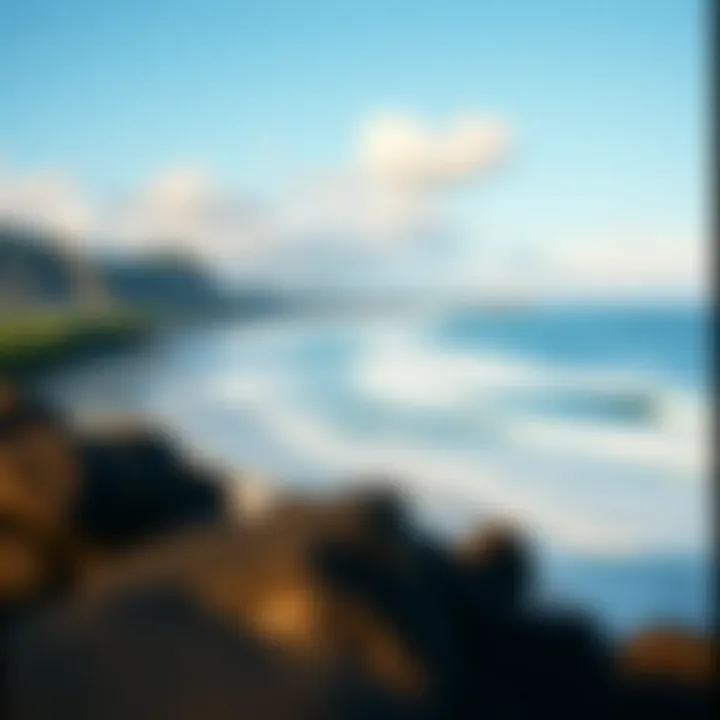
Essential Equipment for Wind Surfing
When stepping into the exhilarating world of wind surfing, proper equipment acts like a sturdy lifeline connecting enthusiasts with the sport. Choosing the right gear can make all the difference, turning a challenging day on the water into a seamless ride, or vice versa. Those who are serious about wind surfing in Oahu, or anywhere else for that matter, must understand the significance of every item, from boards to safety gear, ensuring that they embark on their surfing adventures well-prepared.
Boards and Sails
The board and sail are the heart and soul of wind surfing. Without these, you're just standing on the water—literally. Choosing the right board ties directly into your skill level and the conditions you plan to surf in. A beginner might lean towards a wider board for stability, while more seasoned surfers often prefer narrower boards that offer greater speed and maneuverability.
- Types of Boards: Wind surfboards come in various styles:
- Freeride: Perfect for cruising on flat waters, allowing novice surfers to practice.
- Freestyle: Ideal for doing tricks, often shorter and more maneuverable.
- Wave boards: Best for surfing through rough waves with precise control.
Sails also vary significantly; they differ in size, shape, and material. For those just starting, a larger sail might be easier to handle, while advanced surfers often choose smaller sails for better control and speed. Notably, materials used such as monofilm or mylar can influence durability and performance under various wind conditions.
Customization is key. As a surfer grows in skill, customizing their rig with specific boards and sails that fit personal style can greatly enhance the overall experience.
Safety Gear
Whether you’re slicing through waves or coasting on calmer waters, safety gear is non-negotiable. In the world of wind surfing, unique challenges come with the territory, including unpredictable winds and powerful currents. It doesn't take much to get caught in a rough spot, and having the right safety equipment can be the difference between a harrowing experience and a smooth session.
- Essential safety items include:
- Impact vest: Provides floating assistance and protects against falls.
- Leash: Ensures your board doesn’t drift away if you fall off, a real lifesaver.
- Helmet: A must for advanced maneuvers where the risk of hitting something—like your board or unexpected rocks—exists.
It’s worth remembering that water conditions can vary greatly, especially in a dynamic environment like Oahu. Hence, keeping safety gear in top condition, along with a clear understanding of how to use it, enhances personal safety and promotes a more enjoyable experience.
Maintenance and Upgrades
Keeping equipment in good shape isn’t only about enhancing performance but also prolonging the life of your investment. Lack of proper maintenance can lead to costly repairs or even injuries. Regular inspection of both boards and sails is prudent. Look for:
- Dings or cracks: These can occur easily and affect hydrodynamics.
- Wear and tear on the sail fabric: This can lead to reduced speed and control.
Beyond basic upkeep, savvy wind surfers often find joy in upgrading their gear. Maybe adding a lighter-weight sail or purchasing a new board that better suits evolving skill levels. Taking steps to stay at the forefront of wind surfing technology can significantly improve overall performance.
Investing time and resources into understanding equipment not only enhances individual skill but also deepens appreciation for the intricate sport of wind surfing.
Techniques for Successful Wind Surfing
In the vibrant world of wind surfing, mastering techniques is more than just a necessity; it’s the very crux of the sport. Understanding how to maneuver and adapt on the water can be the deciding factor between a thrilling ride and an uncomfortable tumble into the waves. The unique combination of wind and water conditions in Oahu provides both challenges and rewards, making proficiency in wind surfing techniques essential for anyone looking to ride the waves here.
The benefits of honing these skills are manifold. Not only does it enhance your overall performance, but it also contributes to a safer surfing experience. Knowing how to execute basic maneuvers, tackle techniques like tacking and jibing, and even attempting advanced tricks can boost your confidence on the water. A solid technique foundation can transform your wind surfing journey from a simple hobby into a fulfilling lifestyle.
Basic Maneuvers
Before embarking on the more complicated aspects of wind surfing, getting a grip on the basics is crucial. Basic maneuvers include starting, stopping, and turning. These might sound simple, but they form the framework for everything else.
- Starting: To begin, set your sail facing the wind, grab the mast with both hands, and step onto your board in one quick motion. The key here is balance; try to keep your body centered over the board.
- Stopping: To halt your progress, pull the sail towards you while leaning back slightly. This shifts your weight and allows the board to slow down effectively.
- Turning: For changing direction, a basic turn involves tilting the sail in the opposite direction of the board. Pressure on your heels or toes helps shift your weight accordingly.
These fundamental movements not only keep you upright but also prepare you for more complex actions. As they say, you gotta walk before you can run.
Tack and Jibe Techniques
Once you've mastered the basics, it’s time to advance into tack and jibe techniques. Both are critical for navigating the water effectively and efficiently, especially in Oahu's gusty conditions.
- Tacking is essentially turning into the wind. Start by pulling the sail back to your hip. As the board begins to pivot, you’ll want to shift your weight and reposition your feet. This move allows you to maintain momentum while changing direction.
- Jibing, on the other hand, is about turning with the wind. This maneuver requires leaning back into the wind while smoothly transferring your weight from one foot to the other as you swing the sail around. The smoothness of this transition is key for maintaining speed throughout the turn.
Both tactics demand a keen understanding of wind conditions, so pay attention. Mastering these techniques could very well keep you out of trouble when that unexpected gust hits.
Advanced Tricks for Experienced Surfers
For those who have spent considerable time on the water, advanced tricks are where wind surfing truly shines. These skills require a combination of strength, balance, and confidence, pushing the limits of what’s possible.
- Jumping: A popular maneuver involves catching the wind and lifting off the water. The trick lies in timing; as you approach a wave, dig your heels down, push against the board, and let the wind lift you.
- Spinning: Completing a 360-degree spin is not just flashy but also showcases your skills. While in the air, pull the sail in and rotate your body.
- Flaka: This trick requires a solid understanding of both balance and timing. By generating speed into a maneuver, you can flip the board while keeping the sail positioned correctly.
Such advanced moves not only impress your fellow surfers but also heighten your connection with the ocean. Each trick tells a story of perseverance and skill honed through practice.
"In wind surfing, every maneuver is a conversation between you, your board, and the wind."
Mastering the techniques of wind surfing in Oahu isn't just about the thrill or the culture—it's about the connection you build with nature, your surroundings, and yourself. Whether you're a novice trying to find your footing or an experienced surfer pushing the boundaries, the techniques learned here are vital for sailing through the wind with finesse and joy.
The Cultural Significance of Wind Surfing in Hawaii
Wind surfing in Hawaii is not just a sport; it embodies a rich tapestry of the island's culture, weaving into both traditional practices and contemporary lifestyle. The waves and winds have long influenced the way people engage with the ocean. For locals and visitors alike, this exhilarating activity is a gateway to understanding Hawaiian traditions, fostering a deeper connection with nature and the community.
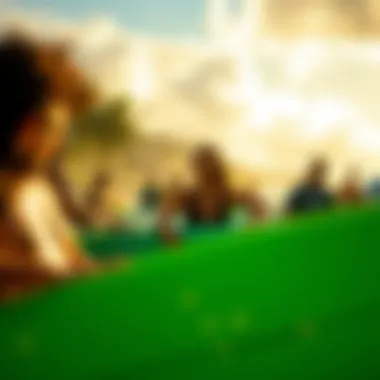
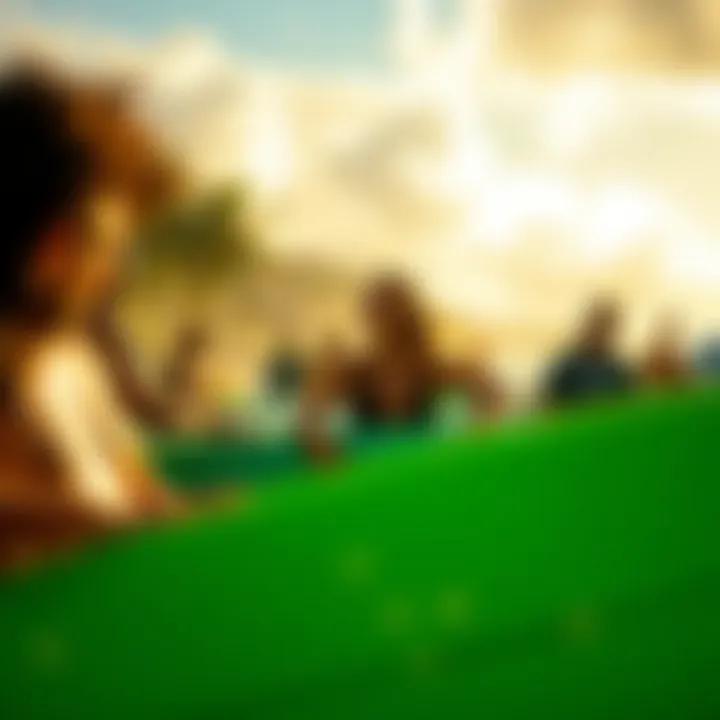
Historical Context
The roots of wind surfing in Hawaii stretch back to times when ancient Polynesians sailed the vast Pacific using wind-powered canoes. They understood the importance of wind and water, skillfully navigating through the islands. While modern wind surfing emerged in the late 20th century, its essence resonates with these ancestral practices. This sport took off on the shores of Oahu, where innovative surfers began blending elements of traditional surfing with the latest technology in sails and boards, adding a dynamic twist to their ocean experiences.
The early days of wind surfing in Hawaii were marked by camaraderie and local gatherings, creating a robust community that still thrives today. Legendary spots like Kailua Beach and Kaneohe Bay became the breeding grounds for this new discipline. The spirit of competition, together with the quest for personal achievement, captures the essence of what it means to ride the wind in these pristine waters. With every gust of wind and roll of the wave, surfers pay homage to their ancestors who roamed these seas long before them.
Influence on Hawaiian Lifestyle
Wind surfing significantly influences the everyday lives of many Hawaiians. It fosters a connection to the ocean that goes beyond recreational enjoyment; it shapes social interactions and local culture. For instance, students from wind surfing schools form tight-knit friendships, sharing tips and honing their skills together. Local organizations often promote sustainable practices alongside teaching surfing techniques, ensuring that environmental considerations are part of the lifestyle.
Moreover, events like the annual wind surfing competitions not only bring surfers together but also serve as a celebration of Hawaiian culture. These gatherings are often accompanied by traditional music and dances, melding ancient practices with modern sporting events.
"Wind surfing is not just about catching the perfect wave. It’s about riding the spirit of Aloha, fostering bonds, respect for the ocean, and preserving a way of life."
As wind surfers glide over the waters of Oahu, they carry with them a legacy that unites them with both the past and the future. This sport encourages respect for nature and community involvement, where every session on the water serves as an affirmation of Hawaiian cultural identity. The simplicity of wind surfing transcends the act itself; it invites everyone—be they natives or tourists—to partake in a shared narrative that honors both the land and the sea.
Environmental Considerations
Wind surfing is not just a thrilling sport; it carries with it a responsibility towards the environment. In Oahu, where the natural beauty is breathtaking, understanding the impact of wind surfing on local ecosystems is crucial. Given the island's diverse marine life and sensitive beach landscapes, it's essential to maintain a balance between enjoying this sport and preserving the environment.
The Impact of Surfing on Local Ecosystems
As enthusiasts ride the waves, they affect various aspects of local ecosystems. The churn of water caused by windsurfing can impact marine habitats, particularly coral reefs. When wind surfers traverse these areas, they can unintentionally damage fragile structures. Coral reefs provide shelter for countless species; thus, preserving them is vital for biodiversity.
Moreover, the noise and disruption from wind surfing can impact wildlife. Birds, which rely on coastal zones for nesting, might be disturbed by the activities on the water, leading to reduced breeding success. It's imperative for surfers to be aware of their surroundings and choose their locations wisely, especially in areas known for wildlife.
"Our actions in these waters echo beyond the shores - every wave we ride affects the whispering coral and the dance of the sea turtles."
To mitigate these impacts, wind surfers are advised to respect designated areas that are less sensitive to disturbances. Engaging in careful navigation can go a long way in protecting marine ecosystems while still enjoying the exhilarating experience wind surfing offers.
Sustainable Practices in Wind Surfing
Adopting sustainable practices in wind surfing not only preserves the environment but also ensures the longevity of the sport for future generations. Here are some guidelines and practices that local surfers and visitors can adopt:
- Choose Eco-friendly Equipment: Opt for boards and sails made from sustainable materials. Several brands are stepping up to develop gear that minimizes environmental impact.
- Educate Others: Informed surfers can spread awareness of best practices within the community. Hosting workshops or sharing knowledge can cultivate a culture of respect for the environment.
- Limit Water Time: Reducing the frequency or duration of sessions in sensitive areas can significantly lessen impact. Find spots that are less affected by surge and crowding.
- Engage in Clean-Up Activities: Regular beach clean-ups foster community spirit and directly benefit the ecosystems that surfers enjoy. Partner with local organizations to either participate in or initiate such events.
By embracing these practices, the wind surfing community can enjoy their beloved sport while respecting the stunning backdrop provided by Oahu's natural landscape. The beauty of wind surfing lies equally in the thrill of the ride and the peace of knowing you are being a caretaker of the ocean.
Community and Local Involvement
Community and local involvement play a pivotal role in the vibrant world of wind surfing in Oahu. When one thinks about wind surfing, often the focus is directed towards the sport itself—the equipment, techniques, and locations. However, the heartbeat of this culture is found in its community. By fostering local engagement, the spirit of Aloha comes alive, creating a tapestry of interconnected experiences that support both the sport and its enthusiasts.
Through community involvement, surfers—be they novices or seasoned veterans—find not just camaraderie, but also a wealth of knowledge and support. Local organizations and schools serve as pillars of guidance, providing structured learning and a safe environment for beginners. These entities play critical roles in ensuring that the next generation of wind surfers not only learns the technical aspects of the sport but also shares and respects the culture that comes with it.
Local Surfing Schools and Organizations
Oahu boasts a variety of local surfing schools and organizations dedicated to wind surfing that cater to all levels of proficiency. These institutions not only teach techniques but also pass down the rich heritage attached to the sport. For instance:
- Aloha Surf School provides comprehensive lessons, ensuring that every student understands safety and etiquette on the water.
- Windward Watersports has been instrumental in promoting wind surfing among the younger crowd, often offering scholarships and special group lessons.
- Hawaii Windsurfing has regular clinics, providing a space for surfers to improve their skills and connect with fellow enthusiasts.
Through partnerships with local schools, these organizations can engage the community by organizing workshops and demos. Their efforts foster a strong sense of belonging and often lead to a greater awareness of environmental concerns tied to wind surfing.
Community Events and Competitions
Community events and competitions enrich the wind surfing culture in Oahu. They not only showcase the prowess of local surfers but also bring people together, nurturing a spirit of friendly competition. These gatherings often feature:
- Weekly Beach Clean-ups: Many local surf schools collaborate with environmental groups, where participants clean up beaches, ensuring that the spaces we surf remain pristine.
- Annual Wind Surfing Competitions: Events like the Hawaiian Wind Challenge attract participants from various backgrounds, creating excitement and community pride.
- Family Fun Days: Events that are designed for all ages promote inclusivity, where families can learn the sport together and build lifelong memories.
Quote: “Surfing in Hawaii isn't just a sport; it’s a way of life that thrives on community engagement and respect for the ocean.”
The sense of community extends beyond the competitions themselves. Local shops and restaurants often sponsor these events, further enhancing the local economy while promoting the sport. The bonds formed during these events lay the groundwork for a supportive network that encourages surfing as a sustainable lifestyle choice. This ecosystem is crucial not only for the enjoyment of wind surfing but also for the environmental stewardship necessary to preserve Oahu's beautiful coastlines.
Ending and Future of Wind Surfing in Oahu
Wind surfing in Oahu is more than just a sport; it represents a blend of nature, technology, and community spirit. As we look to the future, it's crucial to appreciate both the current dynamics and the upcoming trends that will shape this exhilarating activity.
Trends in Wind Surfing
The landscape of wind surfing is continuously evolving. Here are some key trends that are worth noting:
- Growing Popularity among Beginners: With more schools and rental shops springing up, newcomers are diving into the sport at a rapid pace. The accessibility of equipment and instruction has made it easier for those who once thought wind surfing was out of reach.
- Increased Focus on Sustainability: Environmental awareness is gaining traction. Many surfers are now opting for eco-friendly gear and supporting local initiatives aimed at preserving the beaches and marine life.
- Technology Integration: Innovations such as smart boards and sails are designed to enhance performance and safety. These advancements allow surfers to track their progress and receive real-time feedback, creating an even more immersive experience.
"Wind surfing acts as a bridge between our love for adventure and our responsibility towards Mother Nature."
Looking Ahead: Innovations and Growth
As we peer into the future, several exciting innovations could revolutionize the wind surfing scene in Oahu:
- Smart Equipment: Developments in boards and sails that integrate sensors may provide surfers with metrics on speed, wind direction, and wave patterns, optimizing the sport experience.
- Virtual Reality Training: This technology may allow beginners to learn techniques in a simulated environment before hitting the water. Such tools can reduce the learning curve significantly, helping novices gain confidence.
- Community-Driven Initiatives: Grassroots movements focused on environmental conservation and local culture can foster a sense of belonging among surfers, establishing a tight-knit community that enriches the wind surfing experience.
The spirit of wind surfing in Oahu is rooted deeply in its local culture. Embracing sustainable practices, investing in technological advancements, and fostering a vibrant community will not only secure the sport's legacy but also enhance the enjoyment of future generations. Oahu stands as a beacon for wind surfers worldwide, marrying the thrill of the sport with the beauty of nature—a testament to what the future holds when passion meets responsibility.















